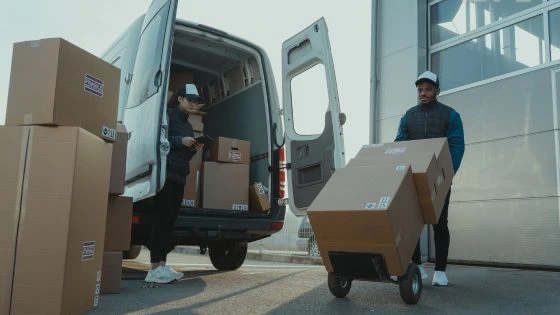Last Mile: What Is It and Why Is It Important in Logistics?

The term last mile refers to the final delivery process of a product or service from a distribution point to the end customer.
You’ve likely experienced delays in receiving a package, or perhaps received a product that arrived damaged, dented, or broken. Maybe you’ve even received a notification saying your order was delivered, but it never made it to your hands. These issues often stem from challenges in managing last-mile logistics.
What Is the Last Mile?
Last mile is a term widely used in logistics and distribution to describe the final stage of the delivery process for goods or services, from a distribution center or storage point to the end customer.
This stage is critical because it directly connects the provider with the consumer, influencing not only customer satisfaction but also the operational efficiency of the entire supply chain.
The goal of the last mile is to ensure that products arrive quickly, securely, and efficiently at their final destination, meeting customer expectations in terms of time, quality, and convenience.
In the logistics chain, the last mile represents the final link in the process. It typically starts at a warehouse, distribution center, or consolidation point and ends at the address provided by the customer.
The term is applicable across various industries, including:
eCommerce: Delivery of online purchases.
Food services: Restaurant and grocery deliveries.
Healthcare: Delivery of medications or medical equipment.
Omnichannel retail: Shipments from physical stores or distribution centers.
Key Challenges of the Last Mile
The last mile is one of the most complex stages in logistics, as it must ensure fast, accurate, and cost-effective deliveries in increasingly demanding environments. Here are some of the main challenges:
1. Distance from the End Customer
One of the biggest challenges is the distance between the warehouse and the customer, which increases delivery times and costs. To address this, companies must maintain a ready-to-operate fleet, plan optimal routes to reduce fuel consumption, and strategically decide which warehouse to ship orders from.
2. High Costs
The last mile accounts for a significant portion of the total logistics cost, often reaching up to 53%. These costs are driven by factors such as geographic dispersion, failed deliveries, and inefficiencies in route planning, making it difficult to optimize resources and maintain profitability.
3. Operational Complexity
The last mile involves multiple variables, such as traffic conditions, customer availability, and access challenges, like rural areas or buildings without elevators, adding complexity to the delivery process.
4. Environmental Impact
Individualized transportation to multiple destinations significantly contributes to carbon emissions. Sustainable alternatives like electric bikes, hybrid vehicles, and drones are being implemented to deliver more eco-friendly and efficiently.
5. The Need for Specialized Technology
Tools for real-time tracking and route optimization are essential. Technologies like artificial intelligence (AI) and big data help plan logistics more effectively, minimizing time and costs. Features like automated alerts and constant updates keep customers informed throughout the process.
6. Customer Expectations for Speed
Customers highly value fast and reliable deliveries, such as same-day shipping or 24-hour delivery. Any delay can negatively impact customer perception and satisfaction.
7. Growth of eCommerce and High-Demand Seasons
During peak seasons, order volumes skyrocket, straining logistics infrastructure. Companies must quickly adapt to these demand surges to meet delivery deadlines and maintain customer satisfaction.
Overcoming these challenges requires innovation, investment in technology, and strategic planning to balance customer expectations with operational efficiency and sustainability.
How Does the Last Mile Work?
The last mile functions as the final stretch of the logistics process, where products are transported from a distribution center or store to the end customer. While the specifics vary by industry, the general process involves the following stages:
Order Preparation: The process begins with preparing the order at the distribution center or warehouse. This includes activities like packing, labeling, and consolidating items for delivery if multiple products are going to the same customer.
Transportation Assignment
: Once ready, the order is assigned to a delivery vehicle or service provider. Delivery methods may include vans, motorcycles, bicycles, drones, or even automated pickup points.
Route Planning: To optimize time and costs, advanced technology, such as Transportation Management Systems (TMS), is used to plan efficient routes. Factors like traffic, preferred delivery times, and geographic location influence the route selection.
Tracking and Visibility: Throughout the journey, technology platforms enable real-time tracking for both the company and the customer, ensuring transparency and building trust in the process.
Customer Delivery: The order is delivered to the provided address or a pre-arranged pickup point. Often, delivery confirmation is required, either through a customer signature or photo proof.
Incident Management: If the customer is unavailable or issues arise, the delivery is rescheduled or alternative solutions are sought. Communication with the customer is key to quickly resolving any problems.
The last mile is a complex process that integrates logistics, technology, and communication to ensure orders reach the end customer quickly, efficiently, and with a personalized touch. Its success depends on the seamless coordination of various elements to overcome inherent challenges.
Tools and Key Technologies in the Last Mile
Key tools and technologies play a vital role in optimizing processes, reducing costs, and enhancing the customer experience. These solutions help manage the complexities of the last mile, addressing challenges like geographic dispersion, punctuality, and sustainability.
Geolocation and GPS: For real-time monitoring and route optimization.
Artificial Intelligence (AI): To predict demand, plan routes, and allocate resources efficiently.
Mobile Apps: Allow customers to track orders and communicate with couriers.
Electric Vehicles and Drones: Sustainable and efficient solutions for fast deliveries in urban areas.
Big Data: To analyze delivery patterns and continuously improve processes.
By adopting these solutions, companies achieve greater efficiency, sustainability, and an enhanced customer experience, strengthening their position in a highly competitive market.
Importance of the Last Mile
The last mile is critical to the customer experience, serving as the final touchpoint between a company and its consumer, where the delivery promise made during the purchase is fulfilled.
First Tangible Service Interaction: While the customer interacts with the brand during the purchase, delivery is the first physical experience with the product, reinforcing trust in the company.
Meeting Expectations: In a context where consumers demand speed, convenience, and flexibility, effective and timely delivery reinforces the brand’s reliability.
Building Customer Loyalty: A well-executed last mile can turn a one-time buyer into a repeat customer. Companies that consistently exceed delivery expectations enjoy higher retention rates.
Competitive Differentiation: In saturated markets, exceptional delivery experiences can set a company apart, offering same-day shipping or delivery lockers as key advantages.
Efficient Problem Resolution: A seamless last mile facilitates handling issues like returns, rescheduling, or address changes.
Purchase Decision Influence: Fast, free, or convenient delivery options are decisive factors for many customers when choosing where to shop.
Trust and Recommendation: A customer who reliably receives their order is more likely to recommend the brand to others.
Reducing Post-Purchase Friction: A smooth delivery experience avoids complaints or unnecessary returns, improving overall perception.
The last mile profoundly impacts how customers perceive a company. It doesn’t just close the purchase cycle—it determines whether the experience is remembered positively, fostering loyalty, or negatively, harming the relationship.
In today’s economy, where customer expectations are higher than ever, investing in last-mile optimization is essential for building sustainable competitive advantages.


